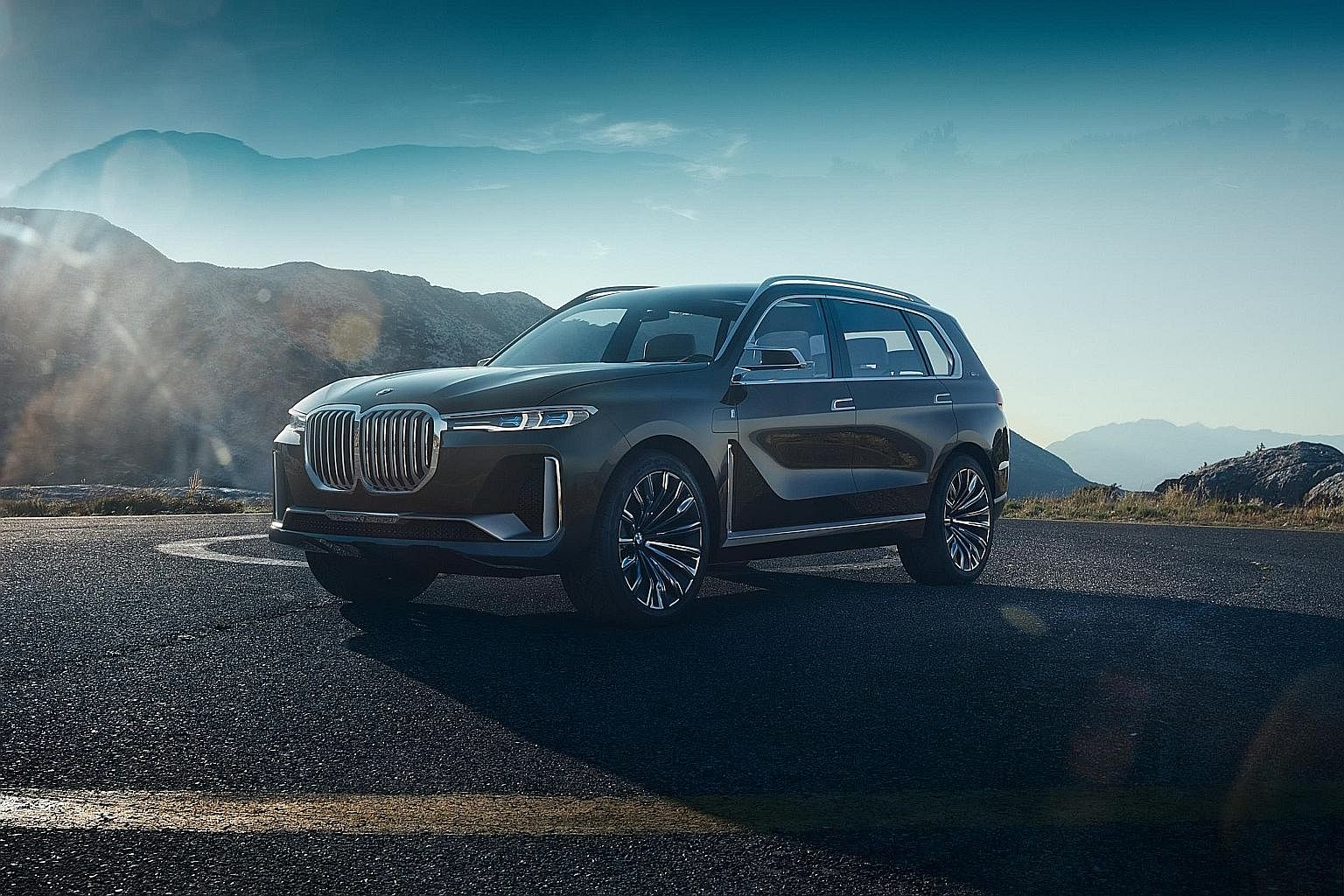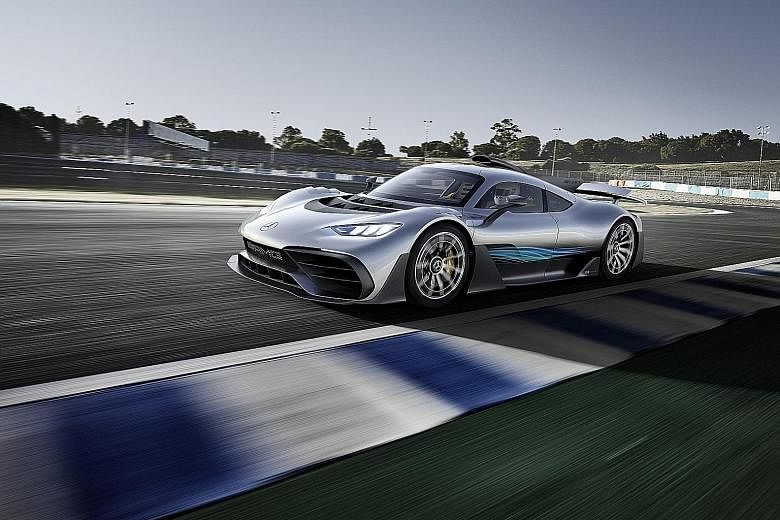F1 hybrid technology for day-to-day driving
The Mercedes-AMG Project One is a two-seater supersports hybrid said to produce some 1,000bhp and reach top speeds beyond 350kmh.
The show car combines outstanding race track performance and day-to-day suitable Formula One hybrid technology.
The car is powered by four electric motors. One has been integrated into the turbocharger, another has been installed directly on the combustion engine with a link to the crankcase and the two remaining motors drive the front wheels.
A 1.6-litre V6 petrol engine with direct injection and electrically assisted single turbocharging comes directly from the Mercedes-AMG Petronas Formula One racing car. The mid-mounted engine can rev up to 11,000rpm, while its electric motors can go up to 50,000rpm.
Lambo SUV out in Dec
Lamborghini will unveil its Urus "super sport utility vehicle" in Sant'Agata Bolognese, Italy, on Dec 4. The company says the Urus will offer "unprecedented SUV performance, luxury and versatility, with the distinctive dynamic design DNA of a Lamborghini super sportscar". It should arrive in Singapore next year.
Honda links electric cars to smart power grid
Honda has come up with a fully integrated energy transfer system which promises to manage energy between the grid, home and electric car.
The system will be launched in a pilot project in France to incorporate electric vehicles into a smart power grid.
It enables the collection and distribution of electricity between the grid, homes and businesses and electric vehicles, to intelligently balance demand and efficient storage of energy.

Biggest BMW SUV
BMW is unleashing its biggest sport utility vehicle, a brawny three-row luxury cruiser targeted at churning out fat margins to help fund the company's shift to electric vehicles. Featuring a massive vertical grille in the brand's trademark kidney shape and glaring narrow headlights, the new X7 (above) will go on sale next year to challenge the likes of the Cadillac Escalade, Lexus LX and Mercedes-Benz GLS, reported Bloomberg. While BMW announced this week plans to roll out 12 battery-powered vehicles by 2025, the bulky SUV will not be entirely at odds with the green-car shift. The company will show the X7, which will be built at BMW's plant in Spartanburg, South Carolina, with a plug-in hybrid powertrain that can drive emission-free for short distances.

Lighter Audi RS4 Avant
Audi Sport has unveiled the new RS4 Avant (above), powered by a 2.9-litre biturbo V6 delivering 450bhp and 600Nm to all four wheels. The car sprints from 0 to 100kmh in 4.1 seconds and on to a top speed of 248kmh. It comes with an optional RS dynamic package. The new RS4 Avant weighs 1,790kg - 80kg lighter than its predecessor. It has an eight-speed Tiptronic gearbox.

Mercedes-AMG two-doors freshen up
Mercedes-AMG is updating its S-class Coupe and Cabriolet with a host of technical and visual highlights. The new-design front end is dominated by a pointy Pan-Americana radiator grille, which now gives the two-door luxury performance range an even more independent look.
In the S63 4MATIC+ Coupe and Cabriolet (above), a 4-litre biturbo V8 with cylinder deactivation (Coupe) supersedes the previous 5.5-litre biturbo V8. Despite the smaller displacement, the new engine puts out 612bhp, 27bhp more than before. Its nine-speed autobox is also new to the Coupe and Cabriolet, as is a fully variable all-wheel-drive system.

Chery's plug-in hybrid crossover
Chinese carmaker Chery has launched a new brand called Exeed. The first model is the Exeed TX (above), a plug-in hybrid crossover. This model combines a 150bhp 1.5-litre petrol engine with an 85kW electric motor to power an intelligent all-wheel-drive system through a seven-speed hybrid drive transmission.
The car is expected to reach 100kmh in six seconds, with a top speed of 200kmh and fuel consumption of 1.8 litres/100km. It has an all-electric range of up to 70km and an electric top speed of 120kmh. Its lithium battery will fast-charge to 80 per cent in 30 minutes and can be fully charged from a 220-volt household supply in just four hours.

Sedric works at the touch of a button
Volkswagen Group's Sedric autonomous concept (above) looks more like a shuttle bus than a car. Its name comes from SElf-DRIving Car and it is expected to form the platform for a diverse model family.
The first VW Group concept car, it "symbolises the transformation of the company from a thoroughbred vehicle manufacturer to an integrated provider of hardware, software and digital mobility services".
The concept for mobility of tomorrow combines fully automated driving, electrification and digital networking. It permits simple, convenient, sustainable and safe mobility for everybody at the touch of a button.

Turning a car into living space
A car as part of your home? Renault's Symbioz concept (above) is touted to be just that. A lifting platform can raise the car from the ground floor to the bedroom or the rooftop terrace on the first floor. Parked on the roof, Symbioz can be turned into a cubby room for relaxation, with a view of the outside. It can be an open space like a living room or it can be a closed space for work where users can seclude themselves from the rest of the house.

TVR Griffith takes off
TVR's new Griffith (above) is a Gordon Murray-designed supercar with 400bhp per tonne, a century sprint of under four seconds and a top speed in excess of 320kmh. The Griffith uses intelligent engineering over electronic driver aids. Only the second front-engine production car to feature a flat floor, the new car boasts a full ground-effect aerodynamic package to ensure that the car remains stable at high speeds. It weighs just 1,250kg and is powered by a naturally aspirated 5-litre Cosworth-enhanced V8 mated to a six-speed manual gearbox.

Extreme Discovery
Land Rover has unveiled the most extreme variant of its Discovery. The Discovery SVX (above) is powered by a 5-litre supercharged V8 with 525bhp. It boasts increased ground clearance, body and suspension lifts, greater wheel articulation, large all-terrain tyres, tuned Terrain Response 2 system, Active Roll Control and a rear-mounted winch.
Electric E-Type
Jaguar Land Rover Classic will offer an electrified version of the classic E-Type. The E-Type Zero is based on Jaguar's 1968 Series 1.5 E-Type Roadster and features a cutting-edge electric powertrain enabling 0 to 100kmh in just 5.5 seconds.
The car will sit alongside the all-electric Jaguar I-Pace, which goes on sale next year.
Jaguar Land Rover has announced that all new cars it produces from 2020 will be electric.
Rear-wheel-drive R8
Audi will make 999 units of a rear- wheel-drive R8. Weighing 50kg less than the R8 Coupe V10 (Spyder 40kg lighter), the R8 V10 RWS produces 540bhp.
It delivers its peak torque of 540Nm at 6,500rpm. The 5.2-litre naturally aspirated engine powers the Coupe from 0 to 100kmh in 3.7 seconds (Spyder: 3.8 seconds) - both 0.2 seconds longer than the all-wheel-drive variants - and on to a top speed of 317kmh (Spyder: 315kmh).
Merc fuel cell
The Mercedes-Benz GLC F-Cell combines fuel-cell and battery technology in the form of a plug-in hybrid. In addition to using hydrogen, the all-electric variant of the popular SUV will also run on lithium-ion batteries.
Intelligent interplay between battery and fuel cell, along with short refuelling times, will make the GLC F-Cell "a vehicle of high everyday practicality and also suitable for long-distance motoring".
With 4.4kg of hydrogen onboard, the pre-production model produces enough energy for a range of up to 437km. It will also benefit from an additional range of up to 49km, courtesy of its lithium-ion power pack, which can be recharged via household wall sockets.
Christopher Tan


